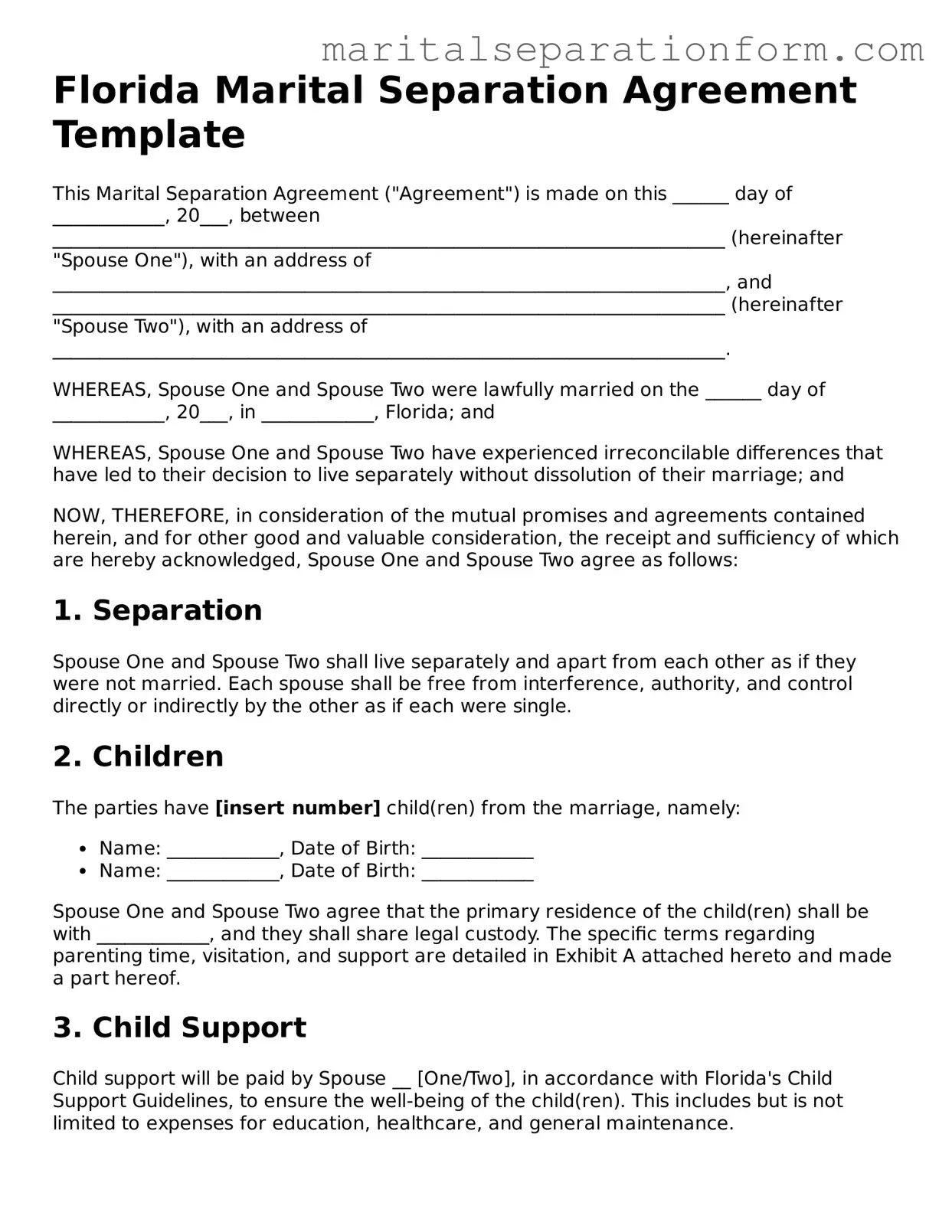Florida Marital Separation Agreement Template
This Marital Separation Agreement ("Agreement") is made on this ______ day of ____________, 20___, between ________________________________________________________________________ (hereinafter "Spouse One"), with an address of ________________________________________________________________________, and ________________________________________________________________________ (hereinafter "Spouse Two"), with an address of ________________________________________________________________________.
WHEREAS, Spouse One and Spouse Two were lawfully married on the ______ day of ____________, 20___, in ____________, Florida; and
WHEREAS, Spouse One and Spouse Two have experienced irreconcilable differences that have led to their decision to live separately without dissolution of their marriage; and
NOW, THEREFORE, in consideration of the mutual promises and agreements contained herein, and for other good and valuable consideration, the receipt and sufficiency of which are hereby acknowledged, Spouse One and Spouse Two agree as follows:
1. Separation
Spouse One and Spouse Two shall live separately and apart from each other as if they were not married. Each spouse shall be free from interference, authority, and control directly or indirectly by the other as if each were single.
2. Children
The parties have [insert number] child(ren) from the marriage, namely:
- Name: ____________, Date of Birth: ____________
- Name: ____________, Date of Birth: ____________
Spouse One and Spouse Two agree that the primary residence of the child(ren) shall be with ____________, and they shall share legal custody. The specific terms regarding parenting time, visitation, and support are detailed in Exhibit A attached hereto and made a part hereof.
3. Child Support
Child support will be paid by Spouse __ [One/Two], in accordance with Florida's Child Support Guidelines, to ensure the well-being of the child(ren). This includes but is not limited to expenses for education, healthcare, and general maintenance.
4. Spousal Support (Alimony)
Following the guidelines under Florida Statutes, Spouse __ [One/Two] shall pay to the other spousal support in the amount of $__________ per month, for a term of __________ years/months, commencing on the ______ day of _______________, 20___, and ending on the ______ day of _______________, 20___, unless otherwise modified by mutual agreement of the parties or by order of a competent court.
5. Division of Property
Spouse One and Spouse Two mutually agree to divide their marital property as follows:
- Real property located at _________________________________ shall be ____________________________________________________________________________.
- Personal property, including but not limited to vehicles, furniture, artwork, and electronics, shall be divided as follows: ________________________________________________________________________________.
- Financial accounts and investments shall be allocated as follows: ________________________________________________________________________________.
6. Debts and Liabilities
Each party agrees to assume responsibility for the debts and liabilities that are individually designated and shall not hold the other party responsible for such debts. The specific allocation of debts is as follows:
- Spouse One shall be responsible for _______________________________________________________________________.
- Spouse Two shall be responsible for _______________________________________________________________________.
7. Entire Agreement
This Agreement constitutes the entire agreement between Spouse One and Spouse Two and supersedes any prior understanding or representation of any kind preceding the date of this Agreement. There are no other promises, conditions, understandings or other agreements, whether oral or written, relating to the subject matter of this Agreement.
IN WITNESS WHEREOF, Spouse One and Spouse Two have executed this Agreement as of the date first above written.
_____________________________
Spouse One Signature
_____________________________
Spouse Two Signature
